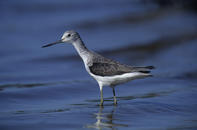
Name
Common Greenshank - Tringa nebularia
Common Greenshank Appearance
The common greenshank can appear very like a marsh sandpiper when wading, but the bill on the greenshank has an upturned appearance and the body is heavier and less slender in appearance. Greenshanks have long green legs and a long bill with a grey base.
When not breeding, the plumage is grey to brown above and a pale white below. During breeding season, the upper body becomes heavily streaked and marked, a bold black chevron type marking becomes visible on the chest.
Diet
The common greenshank feeds on insects, molluscs, crustaceans and small fish. They are surface feeders and feed along the shoreline. They will feed both nocturnally and diurnally.
Common Greenshank Breeding
The common greenshank breeds in the northern hemisphere. (Palaeartic)
Common Greenshank Behaviour
The common greenshank is found alone or in pairs, but very rarely will they be found in groups. To make life difficult in identification, they often feed in the vicinity of marsh sandpipers. The common greenshank feeds along the shoreline in shallow water and can be seen chasing fish into shallow water.
Threats
None
Common Greenshank Distribution and Habitat
The common greenshank is found in fresh and saltwater areas, in marshes, mudflats, lakeshores and lagoons. The common greenshank is found throughout South Africa, except in the very arid areas. They are a summer visitor to South Africa.